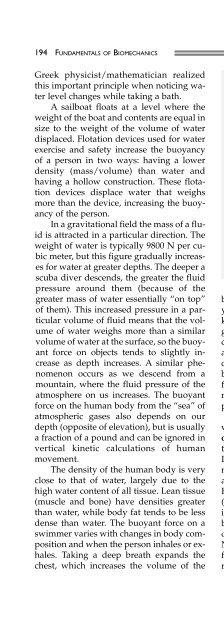Fundamentals of Biomechanics
Fundamentals of Biomechanics
Fundamentals of Biomechanics
You also want an ePaper? Increase the reach of your titles
YUMPU automatically turns print PDFs into web optimized ePapers that Google loves.
194 FUNDAMENTALS OF BIOMECHANICS<br />
Greek physicist/mathematician realized<br />
this important principle when noticing water<br />
level changes while taking a bath.<br />
A sailboat floats at a level where the<br />
weight <strong>of</strong> the boat and contents are equal in<br />
size to the weight <strong>of</strong> the volume <strong>of</strong> water<br />
displaced. Flotation devices used for water<br />
exercise and safety increase the buoyancy<br />
<strong>of</strong> a person in two ways: having a lower<br />
density (mass/volume) than water and<br />
having a hollow construction. These flotation<br />
devices displace water that weighs<br />
more than the device, increasing the buoyancy<br />
<strong>of</strong> the person.<br />
In a gravitational field the mass <strong>of</strong> a fluid<br />
is attracted in a particular direction. The<br />
weight <strong>of</strong> water is typically 9800 N per cubic<br />
meter, but this figure gradually increases<br />
for water at greater depths. The deeper a<br />
scuba diver descends, the greater the fluid<br />
pressure around them (because <strong>of</strong> the<br />
greater mass <strong>of</strong> water essentially “on top”<br />
<strong>of</strong> them). This increased pressure in a particular<br />
volume <strong>of</strong> fluid means that the volume<br />
<strong>of</strong> water weighs more than a similar<br />
volume <strong>of</strong> water at the surface, so the buoyant<br />
force on objects tends to slightly increase<br />
as depth increases. A similar phenomenon<br />
occurs as we descend from a<br />
mountain, where the fluid pressure <strong>of</strong> the<br />
atmosphere on us increases. The buoyant<br />
force on the human body from the “sea” <strong>of</strong><br />
atmospheric gases also depends on our<br />
depth (opposite <strong>of</strong> elevation), but is usually<br />
a fraction <strong>of</strong> a pound and can be ignored in<br />
vertical kinetic calculations <strong>of</strong> human<br />
movement.<br />
The density <strong>of</strong> the human body is very<br />
close to that <strong>of</strong> water, largely due to the<br />
high water content <strong>of</strong> all tissue. Lean tissue<br />
(muscle and bone) have densities greater<br />
than water, while body fat tends to be less<br />
dense than water. The buoyant force on a<br />
swimmer varies with changes in body composition<br />
and when the person inhales or exhales.<br />
Taking a deep breath expands the<br />
chest, which increases the volume <strong>of</strong> the<br />
Activity<br />
The next time you are at a pool, see if you<br />
can detect an increase in buoyant force<br />
with increasing depth. Hold a large sport<br />
ball (water polo, soccer, football) in one<br />
hand and gradually submerge it. Note the<br />
downward vertical force you exert to balance<br />
the buoyant force <strong>of</strong> the ball as it descends.<br />
Also note the horizontal forces<br />
you must exert to keep your hand forces<br />
balanced with the buoyant force and gravity!<br />
Another simple activity is to mark the<br />
water line on a floating ping pong ball.<br />
Tape dimes to the ball and find the maximum<br />
buoyant force <strong>of</strong> a ping pong ball.<br />
Does a forcibly submerged ball have potential<br />
energy?<br />
body and increases the buoyant force. If<br />
you have ever taught a swimming class you<br />
know that people typically fall into three<br />
groups based on their somotype and body<br />
composition: floaters, conditional floaters,<br />
and sinkers. The majority <strong>of</strong> your swim<br />
class can easily float when holding their<br />
breath (conditional floaters). There will be a<br />
few folks who easily float (floaters) or cannot<br />
float (sinkers) without some form <strong>of</strong><br />
propulsion or flotation device.<br />
The buoyant force in water acts upward<br />
at the center <strong>of</strong> buoyancy. The center<br />
<strong>of</strong> buoyancy is essentially the centroid <strong>of</strong><br />
the volume <strong>of</strong> water displaced by an object.<br />
In the human body, the trunk makes up<br />
most <strong>of</strong> the volume, so the center <strong>of</strong> buoyancy<br />
is located 1–2 cm superior (McLean &<br />
Hinrichs, 2000a) to the center <strong>of</strong> gravity<br />
(Figure 8.2). Since so much body volume is<br />
in the upper trunk, moving the rest <strong>of</strong> the<br />
body makes smaller changes in the center<br />
<strong>of</strong> buoyancy than in the center <strong>of</strong> gravity.<br />
Note that the weight force and buoyant<br />
force create a force couple that will tend to<br />
rotate the swimmer's legs down until the






